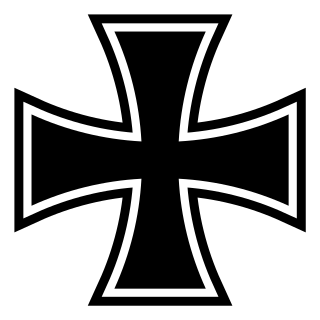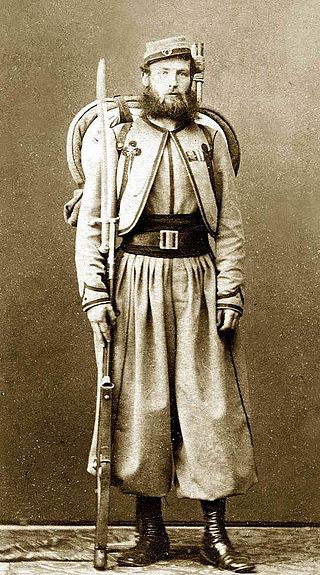
The Iron Cross was a military decoration in the Kingdom of Prussia, and later in the German Empire (1871–1918) and Nazi Germany (1933–1945). The design, a black cross pattée with a white or silver outline, was derived from the insignia of the medieval Teutonic Order and borne by its knights from the 13th century. As well as being a military medal, it has also been used as an emblem by the Prussian Army, the Imperial German Army, and the Reichswehr of the German Republic, while the Balkenkreuz variant was used by the Wehrmacht. The Iron Cross is now the emblem of the Bundeswehr, the modern German armed forces.

Giacomo Antonelli was an Italian cardinal deacon. He was the Cardinal Secretary of State from 1848 until his death; he played a key role in Italian politics, resisting the unification of Italy and affecting Roman Catholic interests in European affairs. He was often called the "Italian Richelieu" and the "Red Pope."

The Order of the Golden Spur, officially known also as the Order of the Golden Militia, is a papal order of knighthood conferred upon those who have rendered distinguished service in propagating the Catholic faith, or who have contributed to the glory of the Church, either by feat of arms, by writings, or by other illustrious acts. With the death in 2019 of the last remaining knight, Grand Duke Jean of Luxembourg, the order is considered dormant.

The Royal and Military Order of Saint Louis is a dynastic order of chivalry founded 5 April 1693 by King Louis XIV, named after Saint Louis. It was intended as a reward for exceptional officers, notable as the first decoration that could be granted to non-nobles. By the authorities of the French Republic, it is considered a predecessor of the Legion of Honour, with which it shares the red ribbon.

The Benemerenti Medal is a medal awarded by the Pope to members of the clergy and laity for service to the Catholic Church. Originally established as an award for soldiers in the Papal Army, it is now a civil decoration but may still be awarded to members of the Pontifical Swiss Guard.

The Order of Pope Pius IX, also referred as the Pian Order, is a papal order of knighthood originally founded by Pope Pius IV in 1560. Currently, it is the highest honor conferred by the Holy See .The awarding of the order fell into disuse and was re-instituted by Pope Pius IX as a continuation on 17 June 1847.

The War Order of Virtuti Militari is Poland's highest military decoration for heroism and courage in the face of the enemy at war. It was created in 1792 by Polish King Stanislaus II Augustus and is the oldest military decoration in the world still in use.

Pro Ecclesia et Pontifice is a decoration of the Holy See. It is currently conferred for distinguished service to the Catholic Church by lay people and clergy.
The Military Cross is a military long service decoration of Belgium. It was established by Royal Decree on 11 February 1885 and is awarded to commissioned officers in the Belgian Armed Forces for loyal and uninterrupted service or to Non-Belgian military officers for distinguished service in favor of the Military of Belgium.

The Battle of Mentana was fought on November 3, 1867, near the village of Mentana, located north-east of Rome, between French-Papal troops and the Italian volunteers led by Giuseppe Garibaldi, who were attempting to capture Rome, then the main centre of the peninsula still outside of the newly unified Kingdom of Italy. The battle ended in a victory by the French-Papal troops.

The Papal Zouaves were an infantry battalion, later regiment, dedicated to defending the Papal States. Named after the French zouave regiments, the Zuavi Pontifici were mainly young men, unmarried and Catholic, who volunteered to assist Pope Pius IX in his struggle against the Italian unificationist Risorgimento.
The Civic Decoration is a civilian decoration of the Kingdom of Belgium. It was first established by royal decree on 21 July 1867 to reward exceptional acts of bravery, devotion or humanity. A further royal decree of 15 January 1885 extended the award to state civil servants for long service by a mere change of ribbon. The award statute was once again amended by royal decree in 1902 to include long service in the Civic Guard and firefighters, each with its distinctive ribbon.
The foreign relations between Pope Pius IX and France reflected Pope Pius IX's hostility to the French Third Republic's anticlerical politics, as well as Napoleon III's influence over the Papal States. But this did not prevent church life in France from flourishing during much of this pontificate.
The Legion of Antibes, also known as the Roman Legion was a formation of the Papal Army created on 8 September 1866 consisting of French Volunteers.

The Karl Troop Cross was instituted on 13 December 1916 by Emperor Karl I of Austria-Hungary. The cross was awarded for service up to the end of the First World War to soldiers and sailors of all arms of the Austro-Hungarian armed forces, regardless of rank, who had been with a combatant unit for at least twelve weeks and who had participated in at least one battle. Members of the air service who made ten flights over enemy lines were also eligible.

The Red Cross Medal was a German medal set up on 1 October 1898 by Wilhelm II. It had three classes and could be awarded to all those who carried out great service to the sick in peace or wartime, or for special achievement in the service of the German Red Cross. Though service to the sick during times of war had been recognized with prior awards of the Order of the Crown and General Honor Decorations with the Red Geneva Cross, Empress Augusta Victoria the royal patroness of the organization wanted an award to recognize work in peacetime as well.
The orders, decorations, and medals of the Holy See include titles, chivalric orders, distinctions and medals honoured by the Holy See, with the Pope as the fount of honour, for deeds and merits of their recipients to the benefit of the Holy See, the Catholic Church, or their respective communities, societies, nations and the world at large.

Hermann Kanzler was a German general who commanded the Army of the Papal States and was the arms minister during the reign of Pope Pius IX. He led Papal forces during the Battle of Mentana against Italian troops.
Charles-Marie-Leon, Count d'Ursel (1848–1903) was a Belgian politician of the Catholic Party.

The Medal Pro Petri Sede, also referred to as Castelfidardo Medal, was a decoration for military merit bestowed by the Holy See in the Second Italian War of Independence during the Italian unification.













